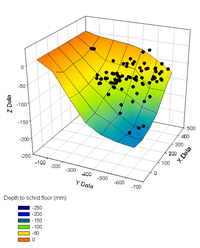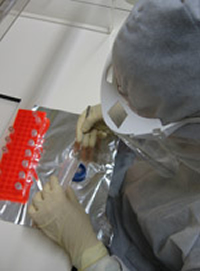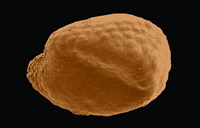Techniques
 The study of coprolites and sediment cores is highly multidisciplinary, so we are using a variety of analytical techniques. An overview of these is provided here.
The study of coprolites and sediment cores is highly multidisciplinary, so we are using a variety of analytical techniques. An overview of these is provided here.
Field sampling
Rockshelter and cave excavations are being carried out with a view to minimising contamination with foreign sediment and DNA. Precautions taken include having a ‘clean-area’ around each excavation pit, where the wearing of Tyvek® suits, latex gloves, and shoe covers is mandatory. The 3D position of all excavated objects (such as coprolites, feathers, bones, eggshell fragments) is accurately measured and recorded so that the relative positions can be plotted later using 3D visualisation software. Once removed from the ground, objects are individually stored in sterile bags or vials to prevent cross-contamination, and kept at low temperature to help preserve DNA. Sediments are sampled stratigraphically for analysis of DNA, pollen, fungal spores, and plant macrofossils.
Sediment cores are being taken from wetland and forest soils using two different methods. First, where soils are hard, compacted, or full of fibrous roots, a square pit is dug using a spade, and a length of drain pipe (sliced in half) is pressed into a face of the pit. The pipe is then held in place while the spade is used to slice around it, and when the pipe is removed it should contain a D-shaped section of the soil. Where sediments are less compacted or silty, or have a high moisture content (such as in wetlands), we use a Russian D-corer. This device consists of a semi-circular barrel that rotates and cuts a D-shaped core around a flat blade that acts as an anchor. The barrel can be pushed to the required depth using the handle and attachable sections of shaft (for more information see Prehistoric Settlement Impacts).
Ancient DNA
 The analysis of DNA from sediment and coprolite samples is carried out at the University of Adelaide’s Australian Centre for Ancient DNA. The world-class facilities are specifically designed for the retrieval of tiny amounts of small or damaged DNA from ancient samples. In the lab, researchers are required to wear Tyvek® suits, hoods, latex gloves, masks and face shields in order to protect the samples against contamination by modern DNA. The lab is positively pressurised for the same reason, and while it is sterilised by UV light each night, every surface or benchtop touched by researchers is frequently cleaned using a combination of bleach, detergent, and alcohol. We hope to use DNA to learn more about the plant material in the coprolites, the birds that deposited them, as well as any parasites the birds may have had. Several coprolites will be examined using metagenomic 454 analysis to examine all DNA present in each sample.
The analysis of DNA from sediment and coprolite samples is carried out at the University of Adelaide’s Australian Centre for Ancient DNA. The world-class facilities are specifically designed for the retrieval of tiny amounts of small or damaged DNA from ancient samples. In the lab, researchers are required to wear Tyvek® suits, hoods, latex gloves, masks and face shields in order to protect the samples against contamination by modern DNA. The lab is positively pressurised for the same reason, and while it is sterilised by UV light each night, every surface or benchtop touched by researchers is frequently cleaned using a combination of bleach, detergent, and alcohol. We hope to use DNA to learn more about the plant material in the coprolites, the birds that deposited them, as well as any parasites the birds may have had. Several coprolites will be examined using metagenomic 454 analysis to examine all DNA present in each sample.
Macropalaeontology
A range of macroscopic remains will be identified from coprolites, including seeds, leaves, invertebrates and wood fragments. The methods for identifying each vary somewhat but mostly involve examination of features using a 1040x dissecting microscope (or SEM for smaller seeds) and comparing with published photographs, descriptions, or herbarium specimens. Wood analysis involves slicing samples at particular orientations and examining the pattern of cell and vessel arrangement.
Micropalaeontology
Micropalaeontological methods being used in this study include analyse of pollen grains and fungal spores, and for phytoliths and starch grains. Selected coprolite examination of pollen will be used to compare with macroremains for interpreting diet, but will also provide an indication of what season a coprolite was deposited (there are higher atmospheric concentrations of pollen during spring/summer than in winter). Identification of coprophilous fungal spores in the coprolites will allow us to directly relate herbivores to certain fungal spores in sediment cores.
 |
 |
| SEM image of Colobanthus seed, found in moa coprolites from the Central Otago region of the South Island. | Spores of the coprophilous fungi Sporormiella from takahē droppings. The spores are less than 10 microns (1/100th of a millimetre) in size. |
Radiocarbon dating
Having good age control on samples is important, particularly for the timing of local extinction events marked by Sporormiella declines in sediment cores. Tiny samples of specifically selected organic material will be taken from cores and coprolites and submitted to the Waikato Radiocarbon Dating laboratory for analysis using accelerator mass spectrometry. The timing of significant events such as local extinctions will be dated more precisely by using ‘wiggle-matching’ of several radiocarbon-dated stratigraphic samples taken from above and below the event.
